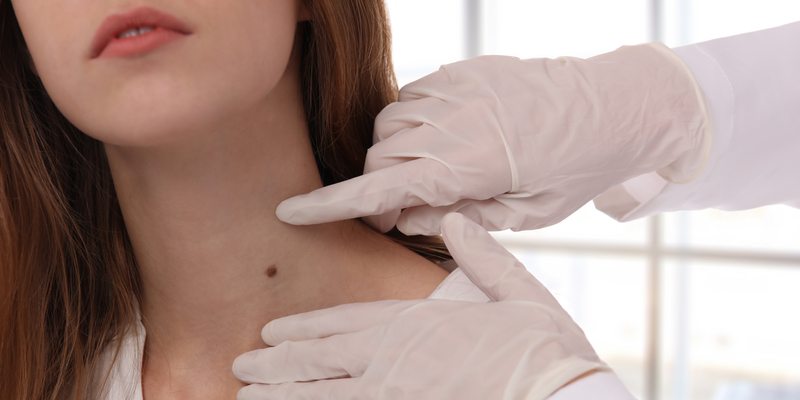Understanding the 3 Main Types of Skin Cancer: BCC, SCC, and Melanoma

According to the American Academy of Dermatology, an estimated one in five Americans will develop skin cancer in their lifetime. Knowing your risk factors, practicing good prevention and early detection strategies, and understanding what signs to look for are imperative to minimize your risks and treat precancerous lesions promptly.
This guide outlines the most common types of skin cancers, which are often grouped into two categories: non-melanoma skin cancers and melanomas. It also discusses the early signs of each type to look for, as well as skin cancer prevention and early detection strategies.
Non-Melanoma Skin Cancers
The two most common non-melanoma skin cancers are basal cell carcinomas (BCCs) and squamous cell carcinomas (SCCs), although there are other more rare types such as Merkel cell carcinoma, angiosarcoma, and dermatofibrosarcoma protuberans.
Basal cell carcinoma gets its name because it begins in the basal cells of your skin. These cells are located in the deepest layer of the epidermis and are responsible for producing new skin cells to replace the older ones on top. BCC is the most common type of skin cancer and usually occurs on sun-exposed areas of your skin such as your face and neck. BCCs typically grow slowly and can vary in appearance. They may look red, pink, yellow, or even transparent and can be shiny, raised, or crusty. Some BCCs resemble an open sore that bleeds or itches and does not heal.
Squamous cell carcinoma is the second most common type of skin cancer and starts in the squamous cells located near the surface of the epidermis. Although they can occur anywhere on your body, SCCs are most common on sun-exposed areas like your face, neck, ears, lips, and shoulders. They can sometimes resemble warts, but can also be rough, scaly patches of skin that crusts or bleeds.
Melanoma
Melanoma is one of the most dangerous types of skin cancer, as it can quickly spread to other parts of the body, while BCC and SCC do not typically spread. Melanomas begin in cells called melanocytes, which produce the pigment melanin to give the skin its color. According to the Skin Cancer Foundation, only about 20 to 30% of melanomas arise from an existing mole. Seventy to 80% form on normal-looking skin.
Melanomas can vary in appearance and can be brown, black, red, white, or even blue in color and are often larger than the size of a pencil eraser. Look for the ABCDEs of melanoma when performing a self skin exam:
- A: Asymmetry
- B: Irregular borders
- C: Varied color
- D: Diameter larger than that of a pencil eraser
- E: Evolution or change in appearance over time
Know that redheads are more susceptible to melanoma because they have less eumelanin to protect against UV damage, while also having more pheomelanin, which has been shown to generate free radicals when exposed to UV light.
Precancerous Lesions
Some skin lesions are called “precancerous” because they are at an increased risk of developing into cancer and should be treated quickly and appropriately. Two common types of precancerous lesions include actinic keratosis (AK) and dysplastic nevus, or atypical mole.
AKs are typically small red or pink spots of rough skin that show up on the face, hands, arms, and other sun-exposed areas. While not all AKs will turn into skin cancer, it is prudent to have your dermatologist look at these spots as a precaution.
Unusual-looking moles can be benign but should be monitored closely, as they can become cancerous. Perform regular self-exams and see your dermatologist regularly throughout the year to make sure these moles do not transform into melanomas.
Skin Cancer Prevention and Early Detection
Proper sun protection, including wearing sunscreen on a daily basis, is the single most effective prevention strategy against all types of skin cancers. While other factors like genetics also play a role in an individual’s risk of developing skin cancer, sun exposure heightens those risks. Make sure you are using sunscreen the right way. Apply at least SPF 15 on a daily basis and higher SPFs when outside for longer periods of time. Use at least ½ teaspoon on your face and one ounce (a shot glass) for your body.
You should also perform a self-check of any moles or suspicious-looking spots on your body. Make a mole map to help you keep track of new moles and changes in existing ones. Anyone at at increased risk for skin cancer – including redheads, people with fair skin, anyone with a history of sunburn or previous skin cancers, or anyone with a first-degree relative with melanoma – should see their dermatologist more than once per year for a check-up.
In Summary
Moles aren’t the only indication of a possible cancerous lesion on your skin. Know what each common type of skin cancer lesion looks like, and perform regular self-exams to keep an eye on any changes to their appearance. Always have your dermatologist look at suspicious spots, as early detection and treatment are paramount.
Follow Baumann Cosmetic on Facebook, Instagram, and YouTube for more skincare advice and news from Dr. Leslie Baumann.
©2019 Metabeauty, Inc.
E


